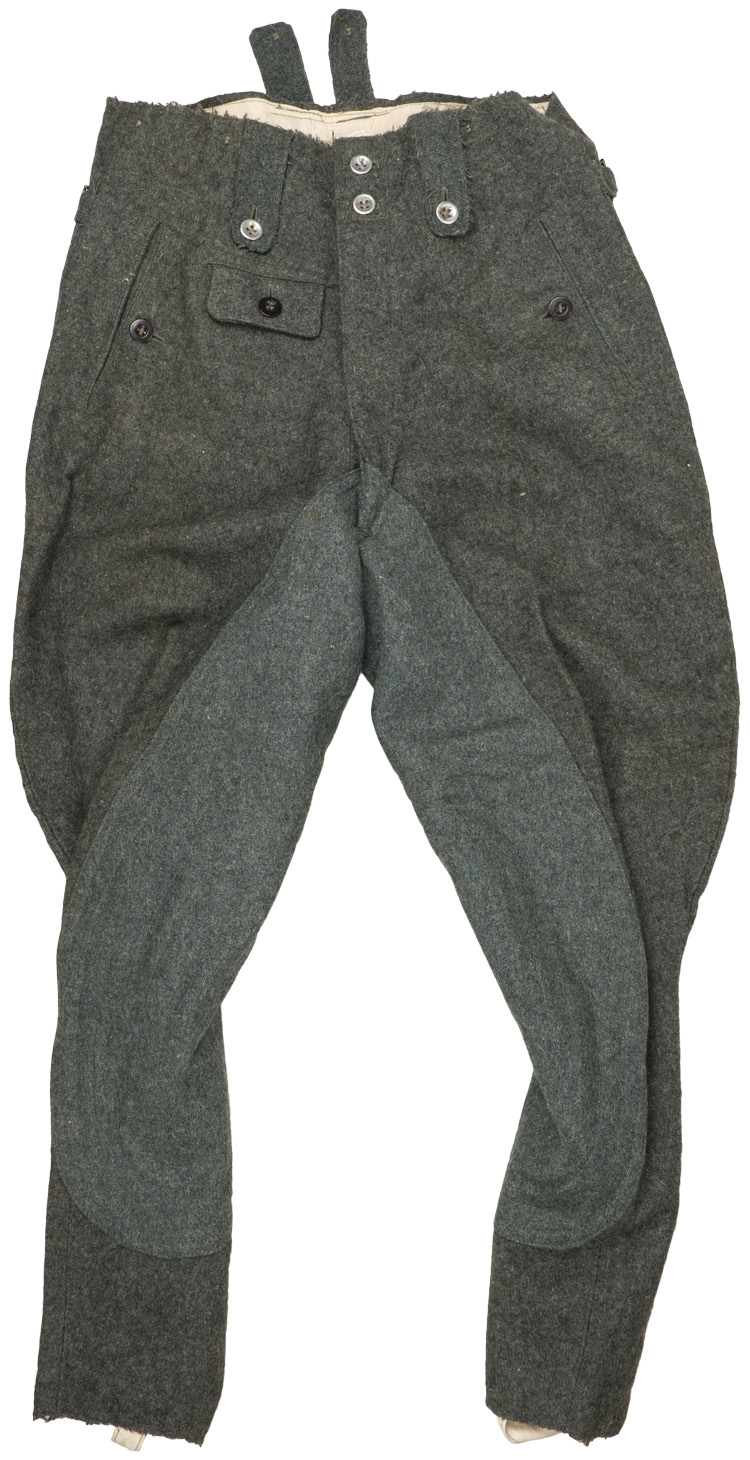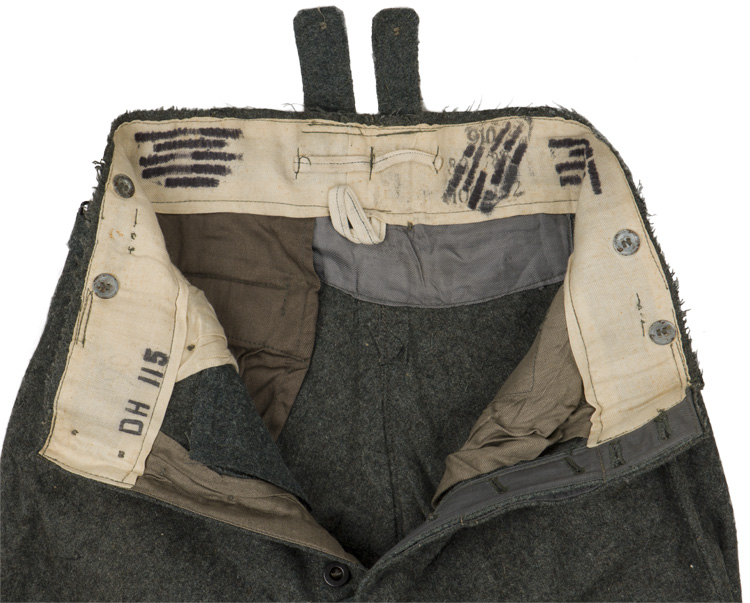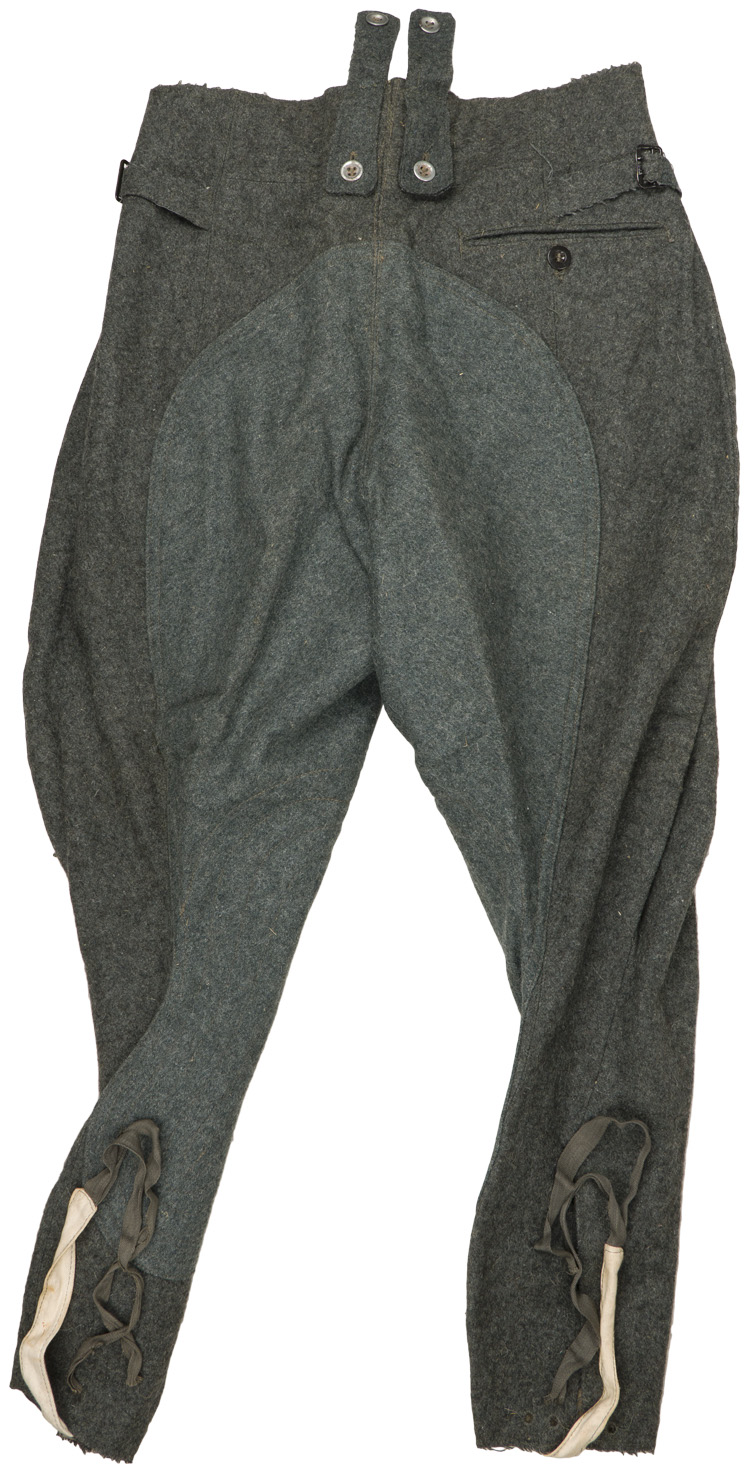


S032266 MOUNTED EM/NCO'S BREECHES.
(Reithose)BACKGROUND: The Allgemeine-SS, (General-SS), was originally formed in May 1923 as the Stosstrupp Adolf Hitler (Shock Troops), and redesignated Schutzstaffel, (Protection Squad), in April 1925 with the official acceptance of the name verified on the second anniversary of the failed Munich "Beer-Hall" Putsch on November 9TH 1925. On January 6TH 1929 Heinrich Himmler was appointed as Reichsführer-SS, (National Leader {of the} SS), and on July 20TH 1934 shortly after the, June 30TH 1934, purge of the SA, Sturm Abteilung, (Storm/Assault Detachment), on the "Night of the Long Knives", the SS was rewarded by Hitler by being granted the status of an independent organization under direct control of the NSDAP Nationalsozialistische Deutsche Arbeiterpartei, (National Socialist German Worker’s Party). Originally members of the fledgling SS had no official uniform until April 1925 when they adopted, what was to become known as the, "Tradition Uniform" and personnel were outfitted with the same brown shirt uniform and kepi as the SA Sturmabteilung, (Storm/Assault Detachment). In November 1925 personnel of the newly formed SS adopted a black kepi, necktie, breeches and border trim on their armbands to distinguish themselves from their SA counterparts. On July 7TH 1932 the black service uniform, for Allgemeine-SS, (General SS), SS-VT, SS-Verfügungstruppe, (SS-Special Purpose Troops), SS-TV, SS-Totenkopfverbände, (SS-Death’s Head Units), and SS-SD, SS-Sicherheitsdienst und Sicherheitspolizei, (SS-Security Service and Security Police), personnel was first introduced to replace the brown shirt, "Tradition", uniform. After the outbreak of WWII the black service uniforms were eventually phased out of wear for all but Allgemeine-SS personnel. In 1935 the first field-grey uniforms were issued to personnel serving with the LSSAH, Leibstandarte SS Adolf Hitler for testing and evaluation and they were adopted as the official color of the field uniform on November 25TH 1935. Along with the field-grey, field blouses, the SS also utilized a wide variety of long trousers and breeches including the dress pants, the standard straight legged long pants, assorted breeches, drill and field pants, tapered "keilhose" pants and assorted specialized pants designed for specific branch of service personnel such as the Mountain troopers pants, Panzer and Assault Gunner’s pants and mounted personnel’s riding breeches. Mounted personnel in all branches of service utilized the riding breeches which were to be worn with most of the uniform types. Originally the seat and crotch of the riding breeches were out-fitted with a leather reinforcement panel which was generally replaced, early in the war, with a dual-ply, field-grey wool or wool blend material reinforcement panel due to leather shortages. Of Note: The RZM, Reichzeugmeisterei, (National Equipment Quartermaster), was official founded in June 1934 in Munich by the NSDAP as a Reich Hauptamt, (State Central Office), and was based on the earlier SA Quartermaster’s Department. The functions of the RZM were not only to procure and distribute items to Party formations, but also to approve chosen designs and to act as a quality control supervisor to ensure items manufactured for the Party met required specification and were standardized. Starting in late 1934 items manufactured for the SS came under the quality control of the RZM and were marked by a cloth RZM/SS approval tag. The dimensions and design of these cloth tags was altered in 1935 and this second pattern tag remained in use until early 1938, when it was replaced by a paper tag. Of Note: In 1943 the Waffen-SS assumed full control over their uniform item production and no longer fell under the authority of the RZM. Also Of Note: SS Officers and certain senior NCO ranks were responsible for purchasing their own uniforms and as a result the SS established the SS-Kleiderkasse, (Clothing Account), system in Munich in 1935. The Officers and certain senior NCO’s were allotted a one time clothing allowance from the government with the amount varying depending on the individuals rank. The Officers and certain senior NCO’s could also choose to purchase privately tailored garments of higher quality although the price may have been restrictive. With the rapid expansion of the Waffen-SS after the outbreak of the war the SS-Kleiderkasse also expanded to include no fewer then nine main offices with offices located in some of the occupied countries including, Poland, Norway, France, Czechoslovakia and Russia.
PHYSICAL DESCRIPTION: Textbook Waffen-SS, coarse, Italian field-grey wool/rayon construction, riding breeches with a subtle bluish tinge, feature a vertical, four button French fly with an additional two buttons positioned on the waistband. The breeches have two, diagonally angled, slash, front pockets with single button closures and a small, horizontal slash, watch pocket, with a straight edged, button down flap, to the right side of the fly. The horizontal waistband has a vertical, button down, belt loop situated at either side of the fly with an additional two, vertical, button down, belt loops to the reverse center. The reverse center of the waistband also has an additional, two, vertically extended, fabric tabs with a single button to each. The reverse of the breeches have a horizontal, slash pocket with a single button closure to the right seat, two, short, vertical tapering darts and two horizontal, fit adjustment straps with corresponding, black painted, dual-claw, sheet metal, "Prima" buckles. The seat, crotch and inner legs have large, dual-ply, field-grey wool/rayon reinforcement panels with repeating oval, reinforcement stitching to the inner thighs, machine stitched in place. The breeches balloon outward at the thighs and taper inwards down to the cuffs. The cuffs each have a short, vertical slash to the outer seams, three stitched eyelets. The eyelets were designed for foot stirrup straps but they have been removed. The interior waistband and internal pocket bags are in ribbed, white cotton/rayon material. The waistband lining has four, evenly spaced suspender attachment buttons. Although they have been marked out with a black marker the property stamps read "Matériel en Location Propriété de Quest-Théatre Ets. Faucheux Angers", (Equipment and House Property of the West Theatre Ets. Faucheux Angers), indicating the breeches were in French possession after the war. The original German size markings are just visible under one of the blacked out stamps. The buttons are a combination of the molded black bakelite and magnetic sheet metal dish types and all appear to have their original stitching. The breeches are roughly size 30" waist. Perfect pair!
GRADE ****3/4 PRICE $1,724.00
To Order this item, please use one of the two e-mail addresses below to contact us. Please make sure to quote the item number in your e-mail
MILITARIA WANTED! If you have items for sale, please contact us. We specialize in selling single pieces and entire collections. Over 3 decades in the business and we do all the work for you. Get the best return for your investment.
-E-Mail Address pawmac@nbnet.nb.ca Or guild@nb.aibn.com
To return to the main page please CLICK below